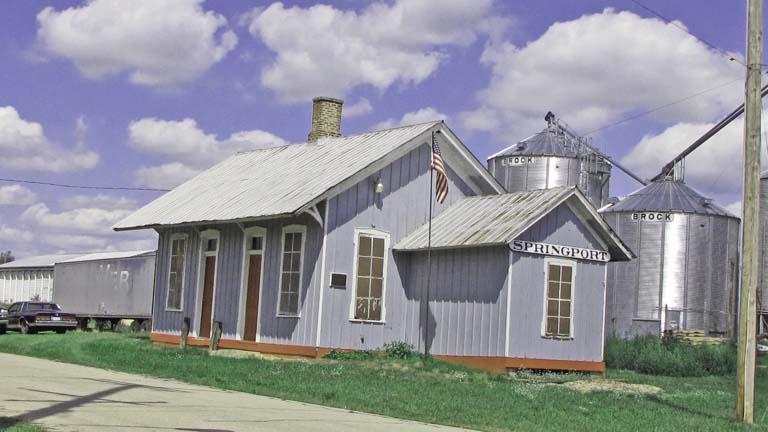

The Lake Shore and Michigan Southern Railroad was a descendent of the rail line that Michigan’s first governor, Stevens T. Mason, proposed in the late 1830s. As part of his program to develop the infrastructure for a modern, prosperous state, he encouraged the building of a line that would stretch from the port of Monroe on Lake Erie to a port on Lake Michigan; that is, across the southernmost counties. At this time, there was a presumption that water was the most convenient way to travel and ship goods since railroads had yet to prove themselves. The consequences of the Financial Panic of 1837 and the state’s inability to borrow meant that construction on that line proceeded very but, by the late 1850s; a Michigan Southern Railroad had been constructed starting in Toledo, going north into Michigan’s southern tier counties and then dipping south to Elkhart, Indiana where connections were made to a rail line to Chicago.
Through a series of mergers, acquisitions, new constructions and the widening of narrow gauge lines, the Lake Shore and Michigan Southern Railroad, by the summer of 1869, owned a main line from Buffalo to Toledo where two main lines extended to Chicago: one directly through northern Indiana and then other through southern Michigan and then Indiana. By 1877 Cornelius Vanderbilt controlled this railroad and used it as a major component of his effort to dominate transportation from the Midwest to the east coast. He assembled the New York Central Railroad system and, in 1915, the Lake Shore and Michigan Southern disappeared into the New York Central. He also controlled the Michigan Central Railroad but that line maintained some independence until it fully became a part of the New York Central in the late 1920s.
The years after the Civil War were ones of great railroad building in Michigan. Manufacturing was booming throughout Michigan capitalizing upon the state’s minerals and the great stock of white pine. However, in this era many manufacturing firms used water power. By the 1890s, technological improvements in steam engines changed the type of energy firms used but, in the early manufacturing era; Ypsilanti, Lansing and Grand Rapids became emerging industrial centers because of their supply of water power. Through purchases of other lines and the building of branches, the Lake Shore and Michigan Southern tapped the market in all three of those centers as well as Detroit. That is, the main line of the Lake Shore and Michigan Southern traversed the southern tier of counties but the line built or purchased branches to growing manufacturing centers of Michigan. Through their subsidiary, Northern Central Michigan, the Lake Shore and Michigan Southern constructed a line north to Lansing in 1872. The southern point of this branch railroad was Jonesville, Michigan located on their southern tier main line. By September of 1872, the line reached Springport and, by January, 1973, it got to Lansing, the northernmost point ever served by the Lake Shore and Michigan Southern. Presumably, the depot you see pictured here was constructed by the railroad’s work crews shortly after the arrival of the line. It has been well restored.
In 1910, two passenger trips made the Lansing to Hillsdale round trip every day except Sunday. You could depart from Springport at 9 AM or 3:40 PM for the hour long ride to the state’s capital; returning at either 9:30 AM or 4:15 PM. If you took the passenger train south to Hillsdale, you could connect to trains destined for Fort Wayne, or Chicago or for Toledo and points east.
The line going north from Springport to Lansing was abandoned in 1941 but there was sufficient business for the line extending south from Springport to survive to the peak era of railroad abandonment in Michigan. That is, the final rail lines serving Springport were abandoned in 1968.
There are at least two Springports in Michigan. One is in Alcona County. The Springport whose depot is shown here is in Jackson County, 28 miles south of Lansing. John Oyer founded this settlement in 1836 and it was originally known as Oyer’s Corners. However, springs were located in the area and, two years later, the name was changed to its current one. The establishment of a post office awaited the arrival of the Lake Shore and Michigan Southern. In 1883, it was incorporated as a village. Census 2010 counted 800 residents of the village, an increase of 96 in the decade since 2000.
Date of construction: Early 1870
Architect or designer: Unknown to me
Architectural style: Board and batten railroad depot
Use in 2013: Well-maintained but apparently empty building
Tracks in front of depot. The Lake Shore and Michigan Southern tracks were removed.
State of Michigan Registry of Historic Sites: Not listed
National Register of Historic Places: Not listed
Photograph: Ren Farley; August 15, 2012
Description prepared: December, 2013
Return to Transportation
Return to Homepage